#National Hill Climb Association
Explore tagged Tumblr posts
Text
When it comes to leaving students with crushing debt they can’t repay, America’s richest colleges and universities are often the worst perpetrators.
Under a new congressional bill, those institutions could face millions in fines if they don’t start giving students a better deal.
The idea – known as “risk sharing” – is one of a slew of far-reaching provisions included in a massive overhaul of the higher education system that was proposed by House Republicans earlier this month. The College Cost Reduction Act, introduced by Rep. Virginia Foxx, R-N.C., chairwoman of the House education committee, is the GOP’s suggested template for finally reauthorizing the Higher Education Act, a sweeping 1960s-era federal law that governs colleges.
The law is supposed to be reauthorized every five years. But the last time it was renewed was in 2008. It has been in place through temporary extensions ever since. In the interim, the country’s runaway student loan debt problem has reached crisis levels as the average price of college tuition climbed to new heights.
Many ideas in the 224-page GOP bill have already prompted blowback from Democrats and higher education advocates. Republicans, for instance, want to slash the amount of money that students can borrow for college. Under the bill, they wouldn’t be able to take out more than $50,000 in total for undergraduate programs or $100,000 for graduate programs.
That cap would be a huge change. It also could limit students without grant money to pursuing their studies at a limited number of schools.
Some of the GOP’s ideas about how to fix the federal student loan system would crush many American families, according to Sameer Gadkaree, president of the Institute for College Access & Success.
“This could mean that some borrowers would stay in debt for the rest of their lives,” Gadkaree said in a statement responding to other proposed changes in the bill that would alter income-driven repayment plans.
The Republican proposal is a big bill with lots of ideas – some radical and others that almost everyone agrees on. Because the legislation is so massive, it’s nearly impossible it would move very far in this Congress, which has experienced historic levels of gridlock.
Yet bipartisan sentiment is growing on Capitol Hill to make higher education more affordable – President Joe Biden has made that argument a central component of his attempts at broad student loan relief. Even in their attacks on those efforts, Republicans have leaned on bipartisan criticism of the rising cost of college in America.
“We want there to be quality assurance in the education that students are seeking,” Foxx said in an interview with USA TODAY. “Too much of the focus of the colleges and universities has been on milking the students and parents.”
A House aide not authorized to speak publicly about the legislation told USA TODAY that Democrats vehemently oppose it. Republicans did not consult them when crafting it, the aide said, as they would do with more bipartisan legislation.
Karen McCarthy, the vice president of public policy and federal relations at the National Association of Student Financial Aid Administrators, said colleges are still parsing through the bill. She said her group is waiting to hear feedback from more schools.
“We’re always on the lookout for unintended consequences,” she said. “With any bill of this size, we always have things that we like and areas of concern.”
Which colleges would see the biggest fines?
One radical change proposed in the bill would effectively make colleges, not student loan borrowers, financially responsible for unpaid loans.
According to a summary of the bill, schools would essentially be on the hook for paying their graduates’ loans back if those students didn’t end up earning as much money as the college predicted.
An analysis of the bill from The Foundation for Research on Equal Opportunity, a conservative think tank, estimates that private schools would face hundreds of millions of dollars in fines for leaving students saddled with debt. The University of Southern California, for example, would risk a roughly $170 million annual penalty. The school did not respond on the record to a request for comment on the proposed fine. Neither did the University of Phoenix, which also would face tens of millions in penalties.
Preston Cooper, a higher education researcher at FREOPP, said the biggest losers under the law would be elite nonprofit schools.
“These places are very heavily reliant on the student loan program,” he said. “The end goal of this is not necessarily to reward or punish different institutions but to change the incentives.”
Democrats oppose idea as higher ed lobby raises concerns over bill
So far, the idea of forcing colleges to pay the government back for unpaid federal student loans doesn’t have bipartisan support. Behind closed doors, Democrats are worried the provision would end up hurting community colleges and minority-serving institutions, the House aide said.
Big players in the higher education lobby have problems with the proposal, too. The American Council on Education hasn't taken an official stance on the bill or any component of it. But Emmanual Guillory, the group’s senior director of government relations, said he shares Democrats' concerns that the risk-sharing provision could hurt colleges that enroll more students from marginalized communities.
Colleges shouldn't be financially penalized for pay gaps in the job market, Guillory said, or for labor challenges in other industries.
"Everyone is not starting from the same starting point," he said. "We can understand the logic, but it just doesn't work that way."
9 notes
·
View notes
Text
HISTORY MATTERS
Irma and I saw John and his wife off at the Tbilisi train station. They were guests of the Georgian Friendship Society With Foreign Countries. But his wife was born in Venezuela, the daughter of a Georgian-father and a Russian-mother. So Irma, from the Society of Compatriots Living Abroad, assisted me with the program. From Krasnovodsk, their route went through Central Asia by train all the way to Beijing. At the time, head of the CIA in Beijing was Robert Fulton, whom I had known since he was the head of the CIA in the USSR a decade ago. Before the train left Tbilisi, I noticed how a Moscow KGB officer secretly climbed into the next car. Apparently, he was supposed to accompany them along the entire route, since he had specially come from Moscow to Tbilisi. A month later I received a letter from John in a DHL China branded envelope. He thanked me for the reception and advised that Intourist drivers should not go out with bald tires to serve foreigners.
1. History Matters
Max (Manny) Granich (1895-1987) was the younger brother of writer Michael Gold (b. Itzok Granich). He joined the Industrial Workers of the World in 1917, participating in several agricultural organizing campaigns in California. He joined the Communist Party USA sometime in the late 1920s, married Grace Maul who accompanied him to Soviet Union, where he did engineering work, and to China. They had been involved in running an anti-Japanese newspaper in Shanghai from 1935-1937 and supervised Cy Oggins. They left just before the Japanese occupied the International Settlement. Just before the Japanese warrant for their arrest. Upon their return, he served as chauffeur and bodyguard for Earl Browder, and (through 1942) as Managing Editor of China Today. Following the postwar expulsion of Earl Browder, the Graniches distanced themselves from the CPUSA and in 1946 founded Higley Hill Camp (Wilmington, Vermont), a left-wing summer camp for children, which they ran until 1964. Grace Granich died in an automobile accident in 1971. In the 1970s, Manny Granich was active in the Chinese-American Friendship Association and led tours to the People's Republic of China. They wanted to have a public program before President Nixon went to China. Thus began the Southbay Chapter, one of the first five in the country.

Grace and Max Granich, 1971
2. Early history China Society
From John Marienthal. US-China Peoples Friendship Association. South Bay Chapter, Friday, April 4, 2014.
"A young woman reporter at a recent National Convention asked how I became interested in China. Two things about China captured my interest. I had recently finished a degree in geography during which. China, being the biggest developing country in the world, was a major topic. How developing countries were to solve their problems was of interest to me.
"Additionally, after spending a year and a half in the Air Force in the Philippines (’64-’66), I became interested in the Vietnam anti-war movement. While in the Philippines, I had observed SEA Countries and China first hand, and I knew none of these countries was strong enough to storm the beaches of Santa Monica and Los Angeles Calif. I knew we were wrong to be in Vietnam.
"I did some reading, and visited China Books and Periodicals. (Later, in 1975 I worked for China Books) I was intrigued that while China was a Socialist country, some of their ideas might benefit the U.S. So, when in Sept of 1971, a friend approached me about forming a China Peoples Friendship Assn, I was only too willing.
"The SF chapter, which was the first chapter in America, started about the same time. In 1972 a chapter was started in Palo Alto. Within a year, Jack Edelman and others started a chapter in Marin County (North Bay). In 1974 we formed a chapter in Santa Cruz.
"Chapters began popping up all over California and the west. There was a professor and some interested students in Fresno—a chapter was born. There were some people who had been involved in United Nations Assn. work in Sacramento—a chapter was born. Groups formed in Seattle, Portland, Los Angeles, Orange County, West Los Angeles, Long Beach, and San Diego. In 1972 Frank Pestana and others formed a regional network. From the west coast, USCPFA blossomed all over. Former member of Central Committee of the Communist Party of Hawaii, OSS linguist, Koji Ariyoshi and family helped form a Hawaiian chapter. Chapters were formed in the Midwest and the East coast.
"In those days, chapters showed Chinese films and foreign documentaries (i.e. Dr. Joshua Horn film) to add to the small number of speakers we could find. The number of people who had been to China was still very small. In 1973 that changed. Youxie offered each of the three areas of our national organization a six person leadership tour to China. That not only helped organize our group into three areas (west, east, Midwest) but was the beginning of many trips to China.
"In 1974 Youxie offered a limited number of visas to tour groups. Potential travelers underwent interviews and had to promise to do outreach programs upon their return. As the visas were limited, couples were not allowed. As part of the newly-formed Western region, I went with this first commercial group of 30 from Hong Kong to Beijing and back."
In 1986 John went to teach in Shihezi, Xinjiang for a year. In 1987 he returned to live and work in China. In 1989 he was on his fifth trip to China.
0 notes
Text

Homemade Gooey Marshmallow S’more with Chocolate and Cookie! S’mores went by Many Names in their 100-Year History—From “Somemores” to “Yummies” to “Toasted Marshmallow Delights." For most of that time, their inventor was unknown. Photograph By Brent Hofacker, Alamy Stock Photo
Who Invented S’mores? Don’t Believe The Myths—This Is The Real History
Lots of People Get Credit for Inventing the Gooey Campfire Treat. But a Woman Named Cookie—Yes, Cookie—Made It into a Culinary All-Star. This is her Story.
— By Dustin Renwick | April 2, 2025
Dorothy Christian Moore knew the rules when she climbed in the dark to the ship’s bridge. “This is strictly forbidden,” she wrote as she crossed the Atlantic Ocean, “and I hadn’t been there two minutes before someone seized me roughly from behind.” She explained to the officer her pursuit of the sunrise, and together they watched the blue horizon split into silver, then blaze to gold—like so many campfires that would define her years in the United States.
She arrived the next morning at the invitation of the Girl Scouts to spend the summer of 1923 sharing her skills. Her stint as a volunteer in an officer’s hospital kitchen during World War I, feeding 150 men a day, had earned her the affectionate nickname “Cookie.” After the war, she continued in public service as a leader in Girl Guides, the first sister organization to Boy Scouts, both created in England.
The overseas appointment proved to be momentous.
Cookie specialized in bringing young women outdoors to learn something of themselves and the natural world. By 1925, she’d published a recipe for a camping dessert, and Girl Scouts across the country reported their experiences with “Somemore,” a sweet sandwich made of graham crackers and half a chocolate bar melted by not one but two toasted marshmallows.

Girl Scouts toasted marshmallows in 1925 at Cedar Hill near Boston, Massachusetts. Some parents might have frowned. “Americans were obsessed with digestion,” explains Helen Veit, associate professor of history at Michigan State University. “People thought children needed extra-digestible food. S’mores wouldn’t have seemed like an obvious children’s food the way they might today.” Photograph Provided By The Girl Scout Museum At Cedar Hill
A century later, the flavor combo has become a favorite well beyond the woods. Girl Scouts of the U.S.A., the national organization, has even released several commercial versions, with the latest official Girl Scout S’mores boxed cookies retiring in 2025.
But Cookie’s extraordinary story vanished, along with the truth about her role in creating a treat that now seems both ubiquitous and everlasting.
Campfire Fairy Tales
Myths can move faster than a woodpile in winter, and the internet has amplified an incorrect and incomplete history of s’mores.
According to the most widespread origin story, the three packable, snackable ingredients were first joined as “Some More” in a 1927 book called Tramping and Trailing with the Girl Scouts. The chapter about hiking meals only includes one person: Kenneth Grahame, author of The Wind in the Willows. His characters, Rat and Mole, are quoted in a discussion of what’s stuffed into a wicker picnic basket: “coldtonguecoldhamcoldbeefpickledgherkinssaladfrenchrollscresssandwichespottedmeatgingerbeerlemonadesodawater.”
More recently, the recipe in Tramping and Trailing was credited to Loretta Scott Crew. She’s as imaginary as Rat and Mole. “We could not find any mention of her,” says Shannon Browning-Mullis, historian for Girl Scouts of the U.S.A. Other relevant archives contain a total of zero references to this alleged troop leader. A 2012 blog post points to a full-blown fakery, and Wikipedia contributors deleted Crew’s page more than a decade ago.
Yet Crew’s name is still cited today, which speaks to a collective yearning for a creator. How could such a celebrated aspect of American childhoods really have no inventor, no genius to applaud? Fiction filled the void.


Left: To pass the proficiency test and earn this Pioneer merit badge from the 1920s, Girl Scouts needed to demonstrate skills that included interpreting the directions of the wind, marking a trail, and cooking outdoor meals. Photograph Provided By The Girl Scout of The USA Collection & Archives Right: “Food here is a revelation. The more I eat of it the more I wonder whatever the Americans must think of English food—or rather English cooking,” Cookie Moore wrote in one of her letters, later published together in 1924 as the book Hail, Girl Scouts! Photograph Provided By The Girl Scout Museum At Cedar Hill
Meanwhile, Dorothy Christian “Cookie” Moore, a blue-eyed Brit with an astonishingly appropriate nickname, is real. A panoramic review of historical records—from 1920s newspapers to candy trade magazines to summer camp reports, personal letters, and photographs—reveals a portrait of an intrepid woman who loved nothing so much as cooking a meal outside with people who were awakening to the wonders of the forests, rivers, and mountains.
Guide on a Mission
When Cookie sailed into New York harbor in May 1923, she didn’t go far. Hours of immigration lines reminded the 34-year-old “of those interminable ‘margarine and cheese’ queues of the worst war years,” she later told her mother. She even helped translate in French and German for the official interpreter to keep the lines moving. Soon, she was heading north of the city to her assignment at Camp Andree Clark, in the sylvan Hudson River valley.
Cookie had cultivated her proficiency in camping when she served as captain of a Girl Guide troop in Bexhill-on-Sea, on the southern coast of England, where she lived with her widowed mother and devised her ideology around encouraging independence.
“Does the average camp give much scope for initiative and resourcefulness?” Cookie asked in a letter home. “Do the children learn to use their hands and muscles constructively? And above all does the method develop Leadership and a sense of responsibility? These are the questions the Powers that be are asking themselves. They realise the enormous possibilities of applied Scouting and, hence—my raison d’etre.”
Cookie Moore arrived at a critical moment for the Girl Scouts, when the organization was one of several competing for political support, financial resources, and the loyalties of girls in the United States. In the early 1920s, active membership in Girl Scouts held a distant second place to Camp Fire Girls, who boasted close connections to the fabulously popular Boy Scouts, with a half million boys.
Lots of People Get Credit For Inventing The Gooey Campfire Treat. But A Woman Named Cookie—Yes, Cookie—Made It Into A Culinary All-Star.
Outdoorsy organizations flourished due to major social changes. Families were moving away from fields and farms and into villages, towns, and cities. The 1920 Census determined that the country was more urban than rural for the first time ever—and children increasingly spent their days indoors at schools rather than working in the fresh air. This shift alarmed some parents and social reformers, says Pamela Riney-Kehrberg, distinguished professor of history at Iowa State University. “There’s this real fear that children are going to be damaged physically, emotionally, mentally, by not having contact with the natural world,” she says. “Scouts allowed children to explore many different activities: sports, hiking, nature, cooking. Opportunity after opportunity.” And unlike school, kids were allowed to choose how they learned about the world.
Scouting boomed for boys, with camping as a centerpiece, but the two girls’ organizations interpreted female abilities quite differently. True to the name, Camp Fire Girls did camp, but the program overall emphasized household roles. One proponent encouraged a fun time with: “Find poetry in washing dishes.” In contrast, Girl Scouts offered a more expansive view of thrills girls might chase, even as they abided by societal expectations for learning household duties.
As Cookie settled in at Camp Andree, the divergent philosophies of the two groups were on display in their monthly magazines where both organizations promoted photography contests. Everygirl published a partial page of general guidance by the national executive of the Camp Fire Girls, a businessman. The American Girl published a two-page spread of technical tricks, critiques of photos, and guidance on how to craft a visual story, all written by Jessie Tarbox Beals, one of the first female photojournalists. A camera “is an instrument of great power and influence if understood and used correctly,” she told her young readers, and even a cheap model, she said, could provide a path to a full-blown career for any Girl Scout.

In 1925, Girl Scout Leaders attended training sessions at Innisfree at Camp Andrée Clark, New York. Pioneering photojournalist Jessie Tarbox Beals was on site to photograph them. Photograph Provided By The Girl Scout of The USA Collection & Archives
Similarly, the Girl Scouts were interested in Cookie as an expert in her field. She had often taken her Bexhill troop on two-week excursions with minimal equipment. “When we move away, you would think the fairies had been there—everything is that right.” American youth camps in 1923 were not compatible with such meager infrastructure. They were staged in advance of kids arriving and constructed for “mass camping,” with 100 or more kids concentrated in the main eating and sleeping areas.
“We are using Camp Andree Clark as an ‘out-of-door laboratory’ to try out experiments in camping,” wrote the Girl Scouts national director to other leaders that spring. The grounds were scattered into separate units designed for individual patrols of eight Girl Scouts and two leaders, and Cookie Moore pushed that uncommon model even further.
Off to Innisfree
Trails connected units at Andree with names such as Fairy Ring and Hillside. After some days of learning directions, Cookie trekked to the top of the hill, far beyond Trail’s End, to a newly built cabin that still smelled of fresh logs and mortar. Gray birches stood as the only neighbors around a structure situated at the edge of the wider forest. A cold spring gurgled with fresh water on the other side of the nearby apple orchard. She named the spot “Innisfree,” after a famous poem by William Butler Yeats. “If you’d emptied your pockets and cudgelled your brains for years,” Cookie wrote, “you couldn’t have evolved a more perfect Troop Headquarters than Innisfree.”
This was the beginning of the “pioneer unit,” the first in any Girl Scouts camp. Innisfree served as the daily hub for embarking on rambles to spot hawk and heron nests, distinguish an ash from an aspen, and nourish a profound appreciation for the landscape. Cookie also taught her patrols the technical skills they needed to earn a Pioneer merit badge.


Left: “I wish to encourage Girl Scouts in an art that may someday be their profession,” wrote Jessie Tarbox Beals, one of the first female photojournalists. She made this photo of campers setting up a campsite at Innisfree in 1925. Photograph Provided By The Girl Scout of The USA Collection & Archives Right: Cookie Moore favored simple fare for campfire cooking, with dishes that could be easily prepared on a stick over a fire, like kabobs and s'mores. Photograph By Glasshouse Images, Alamy Stock Photo
The girls dug latrines and pitched their own tents. They made maps and blazed trails. They axed saplings to build camp furniture and played games that honed their observational skills. They worked together as a team to solve problems. “They had three hours’ good snore after lunch,” Cookie noted, “so that they might see something of the wonder and beauty of the short summer nights.”
She noticed and disliked the many pans and utensils her scouts carried on overnight hikes. So her campfire cooking lessons focused on one-pot meals, like Irish stew, and dishes that required only a pocketknife and a good stick from the surroundings.
Girls roasted cheese cubes wrapped in bacon—“Angels on Horseback” in Cookie’s imaginative parlance—and skewered kabobs of beef, bacon, and onion. “They should be the most delicious fare imaginable,” Cookie instructed, seasoned with woodsmoke to a soundtrack of crickets.
Cookie Moore enthusiastically accepted a request to return for another summer in 1924. She brought her gentle criticism of American parenting with her. “You think so much for your children and tell them what to do until there is nothing left for them to think out for themselves,” she told a U.S. newspaper reporter that year. “Primitive camping develops their resourcefulness.”
She believed in the instincts of girls—their desire for independence and their innate love of adventures. She also allowed them to fail, with support, because “nobody ever learned efficiency by watching an efficient person.”
Her faith also carried into teaching Girl Scouts leaders. Wealthy and middle-class women competently advised girls on merit badges for Child Nurse or Canner, but traditional lives in households of the era had not prepared most women to nurture girls working toward badges such as Star Gazer, Athlete, or Pioneer. And a lack of troop leaders was the most significant existential threat to the organization’s continued growth. One leader who spent time with Cookie later recalled that training sessions were the “spontaneous blossom” of the Girl Scouts movement because so many women found themselves gaining confidence alongside their girls.
Cookie’s guidance for leaders in primitive camping, applied scouting, and outdoor cooking came to be known as “Innisfree Weeks,” and that’s where a legendary dessert was soon born.
Birth of the 'Somemore'
Girl Scouts executives continued to formalize and expand a schedule of training events. Wisconsin hosted the National Camp-Field-Education Conference for midwestern leaders in late September 1924, and Pennsylvania hosted the version for eastern leaders in early October. Cookie brought her usual mirth and cheer to both gatherings, and a handful of newspaper reports indicate that she shared something unusual.
The local director for Girl Scouts in Buffalo, New York, relayed to her troops her experience at the eastern conference assembling kabobs and “a new dessert called ‘Somemore’ ” at the end of a camp-wide game of tracking and observation. An assistant local director from Rochester, New York, played on the opposing team, a group that trained directly with Cookie. A few weeks later, the Rochester newspaper published a now-familiar recipe under the heading “Yummie Dessert.”
And after leaders from Kalamazoo, Michigan, had returned from the midwestern conference, the local newspaper reported that kabobs “and ‘summore’ have been introduced on the Scout menu and have already become famous.”
Well, not quite.
Her own writings on the subject are silent, but wherever Cookie went, somemores followed. Then, in the cover story for the May 1925 issue of The Girl Scout Leader magazine—mailed free to all captains, commissioners, and local directors—Cookie published a weekend hike plan with one-pot meals and an easy dessert that required no extra kitchen utensils:
“Somemore”
16 Graham Crackers
4 Hershey Bars
16 Marshmallows
Toast the marshmallows until they are pale brown and “gooey.” Then make a sandwich of the two crackers and half a chocolate bar and put the marshmallow in between. Good!

Marshmallow toasting preferences ranged wildly from the original 1925 instructions of “Pale Brown and Gooey.” Other Points on the Spectrum from Raw to Charcoal: Just Right, Light Brown, Nice Brown, Mellow Brown, and “The More Burned It Gets The Better We Like It.” Photograph By Julia Gartland
Perhaps Cookie took inspiration from Mallomars or MoonPies, both invented in the 1910s. They used the same ingredients as a somemore, but the outer layer of chocolate devolved into a melting mess near flames. Cookie had noticed that Americans craved candy, but she could not have predicted her triumph. A troop leader in Virginia who attended a training course deemed them “most tempting.” Graham cracker crumbs tumbled into the grass at a troop leader training in Illinois, where they smushed melted chocolate with crispy marshmallows and exclaimed, “O, Girl, what joy!”
Girl Scouts in western New York wrote about somemores many times during the 1925 summer camps. A rainy night in late July left the girls in Buffalo, New York, sitting on ponchos watching their friends struggle to light a pile of damp wood. “Then it blazed up beautifully,” they wrote, “and we sang and talked and laughed and toasted ‘Some-mores.’” In a review that echoes across generations, they declared the dessert “food for the gods.”
It became the breakout year for somemores, and by the end of 1925, Girl Scouts in at least 22 states—coast to coast, and from the Great Lakes to the Gulf—had assembled the trio of ingredients around campfires, office stoves, and electric toasters using everything from wood sticks to steel knitting needles.
From the earliest mentions, Girl Scouts established ownership of their novelty and referred to it as the “Girl Scout dessert” or “a Scout specialty.” Troops also tested other names: “samoas” (now a different Girl Scout cookie), “yummies,” and “toasted marshmallow delights.” As part of a national marketing campaign, a marshmallow manufacturer released a recipe booklet in 1925 that included a “Marshmallow Graham Cracker Sandwich,” a tag as unwieldy as it was literal.
“Somemore” worked because it described the food and the feeling. “Every time you eat one, you always go back for more,” concluded the scribe for Troop 7 in her report to the Birmingham, Alabama, newspaper. Cookie once wrote that she admired Americans for their ability to “scrap, at a moment’s notice, lately cherished schemes, in favour of new ones which seem better.” The girls proved her right.
In late 1925, a Minnesota troop called the dessert s’mores—if not the first, definitely one of the earliest examples of the modern apostrophe (and long before internet claims of the word’s creation in a 1938 guidebook written by a man). A century on, s’mores have become a milestone of American childhood and the embodiment of camping.
Cookie’s Cookie
“Already this ‘Innisfree’ idea is spreading about the country,” reported the Girl Scouts national director of the camp department in 1925, and she acknowledged that more American girls were “learning how to be real campers, not merely the ‘summer resort’ kind who do not know how to fend for themselves outdoors.”
Cookie Moore’s hometown newspaper in Bexhill, England, published a letter from her rejoicing that the 1925 camping season had broken records. “So you see, guiding or scouting, it’s all the same the world over. The most use and the best fun of all the strange things we spend our lives attempting to do.”
She continued to teach at camps in Boston and then Chicago, where in 1927, as Tramping and Trailing with the Girl Scouts was published, a newspaper reported that, “The name of Christian Moore is a household word for Girl Scouts everywhere.” The national headquarters estimated that 50,000 girls would participate in pioneer camping that year.
Together with other efforts to develop a generation of leaders, such as including training courses at colleges, Cookie’s work had changed the Girl Scouts’ trajectory of growth. S’mores were a bonus, a sugary tactic in her much broader strategy of inspiring joy out under the open skies.
And yet her story is a study of legacies and what little we control of how the world remembers us.
She headed back to England in December 1928 to rejoin her Girl Guides. Camp Fire Girls tried to rebrand her signature dessert as “heavenly crisps,” yet in 1934, even their official manual conceded a final parenthetical: “(also known as s’mores).” By that point, Girl Scouts counted 350,000 active members, nearly double their former rival.


Left: Riffs on the original s'mores recipe have evolved over the years with some swapping in fruit slices, peanut butter, or even shortbread. But Cookie's classic combo remains the favorite. Photograph By Peter Frank Edwards, Redux Right: Since their debut in 1925, the gooey campfire treats have become such a summertime tradition that they have their own holiday: National S'mores Day, which falls on August 10. Photograph By Big Cheese Photo, Alamy Stock Photo
Unsurprisingly, Cookie opened her own cooking school in 1936. Decades later, she would have read about the 50th anniversary of Girl Scouts, when the organization merged its campfire goody with its even longer history of selling cookies. New in 1962: Some-Mores, a vanilla wafer and marshmallow covered with chocolate.
But no mention of the woman who popularized them. The truth behind the treat had vanished like one of Cookie’s overnight campsites.
Perhaps this anonymity was intentional. Her book of letters was published in 1924 without her name credited. Hail, Girl Scouts! only listed “a Girl Guide” on the cover, and her views on service reflected a similar mindset. “No one is indispensable,” she wrote in 1927. “This should be the motto of every Girl Scout Leader. Once she has realized this, she begins automatically to train others to take her place.”
Cookie Moore lived the rest of her life in Bexhill’s seaside tranquility and never had children. She eventually moved to a retirement home. She meandered into the gardens there, a few months short of her 96th birthday, and died suddenly—in the wilds, as always.
Considering her American escapades of the early 1920s, Cookie once wrote, “I’d give a good deal to be allowed to return and see this wonderful country, say in a hundred years’ time.” If she were to visit this weekend, she wouldn’t recognize much. Innisfree’s log cabin has tumbled. The stone chimney remains as a beacon of the memories, but the old trails have overgrown.
Yet any bewilderment from the current state of the world would fade when Cookie settled onto a blanket among a circle of uniformed girls as a turquoise twilight dusted the horizon and, at her feet, the glow of campfire coals on the confection she helped us learn to love.
#S’mores#Who Invented S’mores#Real History#Homemade | Gooey Marshmallow S’more | Chocolate 🍫 | Cookie 🍪#“Yummies” | “Toasted Marshmallow Delights#Campfire Fairy Tales#Guide | Mission#Gooey Campfire Treat#Cookie’s Cookie 🍪#Cooking 🥘🍳#Camping 🏕️⛺️#Inventors#Food 🍲🥘🍱#Chocolate 🍫#Women
0 notes
Text
Travel to Lac Thuy and enjoy memorable experiences
Vietnam budget travel - Hoa Binh, the gateway to the Northwest, 80-140 km from Hanoi, is an ideal destination for nature lovers and indigenous culture. This land not only has famous landscapes but also preserves unique cultural values that attract tourists to explore…

In 2025, a new and attractive destination has appeared on the tourist map of young people who love to explore - Lac Thuy, a land possessing pristine natural landscapes combined with ancient and sacred spiritual destinations.
Located in the Southeast of Hoa Binh province, just over 80 km from the center of Hanoi, Lac Thuy not only has poetic natural scenery but is also a place where unique cultural and religious values converge. This land is a harmonious combination of Buddhism and Mother Goddess worship - two spiritual cultural streams that have a profound influence on the spiritual life of Vietnamese people.
The most prominent place here is the scenic complex of Tien Pagoda - Mau Dam Da, which is associated with the legends and sacred stories of Trinh Temple, Mau Au Co Temple, Tien Pagoda… Local people tell each other that if you make a pilgrimage here with sincerity, praying for wealth, fortune or love, all will be answered. This is also the reason why every early spring, tens of thousands of visitors from all over the country come to Tien Pagoda to pray for luck, peace and success in the new year.
Not only having spiritual value, the Tien Pagoda complex also owns more than 20 caves along Tung Xe and Huong Tich mountains with natural stalactites of various shapes, creating a mysterious and magical space. Ong Hoang Bay Cave, Co Chin Cave, Suoi Vang Suoi Bac Cave, Cau Be Cave, Ong Hoang Muoi Cave, Cung Tien Cave… are all destinations not to be missed, giving visitors the opportunity to admire the masterpieces bestowed by nature.
For those who love adventure and exploration, Lac Thuy is also an ideal destination with mountain climbing routes, steep stairs along the cliffs to reach mysterious caves. Coming here, visitors not only have the opportunity to immerse themselves in the majestic natural space but also have time to calm down, contemplate spiritual values and find peace of mind.
The journey to explore Lac Thuy will not be complete if visitors do not try to experience the unique cultural features of the Muong people - an ethnic group with a long-standing culture in Hoa Binh. The bustling bamboo dances, folk games such as stilt walking, swinging, throwing cones… are not only entertainment activities but also an opportunity for each person to understand and appreciate the traditional cultural identity of the nation.
Coming to Lac Thuy, visitors cannot miss the opportunity to enjoy famous specialties such as Muong pork, buffalo meat with lom leaves, hill chicken, Hoa Binh wine… The rustic but rich flavors will leave an unforgettable impression, making each trip more memorable than ever.
The special highlight of Lac Thuy in 2025 is the Huong Binh cable car - the first cable car line in Hoa Binh, connecting two scenic areas of Chua Tien - Dam Da (Hoa Binh) and Chua Huong (Hanoi).
This cable car route not only shortens travel time but also opens up an exciting experience: In just over 10 minutes, visitors can cross the white clouds, admire the green valleys and majestic mountain peaks. Without spending hours walking in the forest or climbing mountains, visitors can still easily set foot on sacred lands, fully enjoying the beauty of the Northwest nature from a completely new perspective.
The Huong Binh cable car route not only helps connect two large spiritual tourism complexes but also opens up a complete journey - from the wild, peaceful beauty of Lac Thuy to the magnificence of the Huong Pagoda complex, known as one of the most beautiful Buddhist landscapes in Vietnam.
With its wild natural beauty, the harmonious combination of spiritual culture and folk beliefs, along with the appearance of a modern cable car, Lac Thuy is the perfect choice that you are looking for and longing to conquer. Try to set foot in Lac Thuy once, try to experience the feeling of flying in the sky on the first cable car line of Hoa Binh, to fully feel the peaceful, majestic beauty and pure spirit that this land brings.
Source: https://cheapvietnamtour.com/blog/lac-thuy-new-tourist-destination-in-hoa-binh.php
0 notes
Text
Thi Nai Lagoon - Majestic natural gateway of Binh Dinh
Vietnam Impressive Travel - Thi Nai lagoon is located in Quy Nhon city, Tuy Phuoc district and Phu Cat district, Binh Dinh province. It has an area of over 5000 hectares and is considered the largest saltwater lagoon in Binh Dinh province.

This place is 16km long - home to a diverse flora and fauna system. You can freely explore the mangrove forest with hundreds of species of shrimp, crab, fish, marine life… Thi Nai Lagoon is considered a masterpiece of natural beauty. People come to Thi Nai Lagoon not only to explore a diverse nature but also to learn about the beauty of the history and people of Binh Dinh.
How to get to Thi Nai lagoon From Quy Nhon city, you go along National Highway 19 about 5km to reach Phuoc Thuan commune, Tuy Phuoc district. From here, go a few more kilometers until you pass the gate of Tan Thuan cultural village to reach the fishing village on the bank of Thi Nai lagoon. Because Thi Nai bridge has just been built and put into operation, the way here is very convenient.
Attractive things to do at Thi Nai Lagoon Explore the landscape of Thi Nai Lagoon No matter what time of year you come here, you will always see a picturesque natural landscape. In the early morning, the lagoon has a magical scene because of the sunlight reflecting on the lake surface. In the afternoon, the purple-red sunset reflects on the water, making this place look like a strangely magical fairyland.
Don’t forget to explore Con Chim Ecological Area located next to the lagoon. This place is considered the green lung of Quy Nhon town, with an area of up to 1000 hectares and is home to hundreds of strange bird species.
Visit Thay Boi tower Going to the west bank of Thi Nai Lagoon is Thay Boi (Fortune teller) tower. This sacred place is associated with an ancient legend of the local people. They told each other about a fortune teller who came here to build a tower and practice his profession. He was so good at fortune telling that people had to line up their boats to wait to have their fortune told.
After his death, the tower was also destroyed in a storm and flood. Later, people built a small temple to worship the water god and remember the good teacher.
Take a photo at Thi Nai Bridge Thi Nai Bridge is located across the lagoon. This bridge is known as the longest sea-crossing bridge in Vietnam. The bridge is over 2,400m long and has 54 connecting spans. This is an important trade route between Quy Nhon and Phuong Mai peninsula. Standing on Thi Nai Bridge, you will be able to admire the vast waves and the entire beautiful landscape of the lagoon.
Thi Nai Bridge is also a beautiful photo shoot location in Quy Nhon for couples to make their wedding album. Don't forget to check-in a few photos to commemorate here!
Tourist attractions near Thi Nai Lagoon Phuong Mai sand hill Near Thi Nai Lagoon, there is an equally famous place for you to visit, which is Phuong Mai sand hill . The sand hill is about 100m high. Therefore, when you climb to the top, you can admire the beautiful panoramic view of Phuong Mai peninsula from above. Not only is it a familiar check-in location for many young people, Phuong Mai sand hill also has an equally interesting sand sliding activity!
Explore Phuong Mai peninsula Phuong Mai Peninsula (also known as Nhon Hoi Economic Zone) is a hot tourist destination in Quy Nhon. The peninsula is over 1,300 hectares wide and not only has a diverse ecosystem but also famous beaches such as Nhon Hai Beach, Nhon Ly Beach, Cat Tien Beach… You can freely experience swimming, eco-tourism, resorts… here.
Hon Seo island Hon Seo is a pristine island on Phuong Mai peninsula. Hon Seo is only over 1km wide but extremely beautiful because of nature and no human intervention. Coming to Hon Seo to explore the diverse coral system, stroll on the rocky cliffs, catch sea urchins or camp overnight is wonderful.
What to eat in Thi Nai? Thi Nai Lagoon, Quy Nhon is famous for its seafood and delicious dishes made from fish and snails that are taken from the lagoon. Some delicious dishes you can try are: jellyfish salad with shrimp paste, jellyfish broth, steamed clams, sea urchins, shrimp noodle soup, steamed mackerel, mackerel soup… Every dish is fresh and delicious and prepared according to the very unique recipe of Binh Dinh people.
However, there are not many restaurants around Thi Nai Lagoon. If you want to enjoy delicious seafood, go to the restaurants near Nhon Ly area!
Some restaurants for you to enjoy seafood:
Huong Duong Quan: main road in Eo Gio Ky Co area, Nhon Ly Commune, Quy Nhon
Moc Vien restaurant: Ly Luong village, Nhon Ly commune, Quy Nhon
Hoang Thao restaurant: Eo Gio, Nhon Ly Commune, Quy Nhon
Source: https://impressivevietnamtravel.com/blog/visit-beautiful-thi-nai-lagoon-in-binh-dinh.html
1 note
·
View note
Text
The Land of Smiles: Must-Visit Destinations in Thailand

Thailand, often called “The Land of Smiles,” is a country that effortlessly combines breathtaking natural beauty, rich cultural heritage, and vibrant modernity. With its warm hospitality, diverse landscapes, and myriad attractions, Thailand is a dream destination for all types of travelers. Whether you're drawn to the pristine beaches of the south, the lush jungles of the north, or the bustling streets of Bangkok, Thailand offers an experience like no other.
Bangkok: The Vibrant Heart of Thailand
As Thailand’s capital, Bangkok is a city that never sleeps. A dynamic metropolis, it seamlessly blends traditional culture with contemporary living.
Temples and Landmarks
Bangkok is home to some of the country’s most iconic temples. The Grand Palace, a symbol of Thai royalty, dazzles with its intricate architecture and the revered Emerald Buddha. Nearby, Wat Pho houses the magnificent Reclining Buddha and is a hub for traditional Thai massage. For a scenic temple experience, visit Wat Arun (Temple of the Dawn), which is especially stunning during sunset.
Shopping and Nightlife
Bangkok offers endless shopping opportunities, from the high-end malls of Siam Paragon and CentralWorld to the bustling street markets of Chatuchak Weekend Market. At night, the city comes alive with rooftop bars, nightclubs, and vibrant street food scenes in areas like Khao San Road and Sukhumvit.
Chiang Mai: A Cultural and Spiritual Haven
Nestled in the mountainous region of northern Thailand, Chiang Mai is a stark contrast to Bangkok’s bustling pace. Known for its ancient temples, serene atmosphere, and thriving arts scene, it’s a must-visit for those seeking a deeper connection with Thai culture.
Temples and Heritage
Chiang Mai boasts over 300 temples, each with its unique charm. Wat Phra That Doi Suthep, perched on a hill overlooking the city, is one of the most significant temples in Thailand. Its golden stupa and panoramic views are unforgettable. The Old City area is dotted with historic temples like Wat Chedi Luang and Wat Phra Singh.
Adventure and Nature
For the adventurous, Chiang Mai offers activities like trekking through lush forests, visiting elephant sanctuaries, and exploring hill tribe villages. The Doi Inthanon National Park, home to Thailand’s highest peak, is perfect for nature lovers.
Phuket: The Pearl of the Andaman
Phuket, Thailand’s largest island, is famous for its stunning beaches, vibrant nightlife, and luxury resorts. It’s a hub for beach lovers and water sports enthusiasts.
Beaches and Water Activities
From the lively Patong Beach to the tranquil shores of Nai Harn, Phuket offers a beach for every traveler. Activities like snorkeling, diving, and jet-skiing are widely available. The nearby Phi Phi Islands and Similan Islands are world-renowned for their crystal-clear waters and vibrant marine life.
Nightlife and Entertainment

Phuket’s nightlife is legendary. Bangla Road in Patong transforms into a lively party street after dark, filled with bars, clubs, and street performers. For a more cultural experience, the Phuket FantaSea show offers a spectacular blend of Thai traditions and modern entertainment.
Krabi: Nature’s Masterpiece
Krabi is a haven for those seeking dramatic landscapes and serene beaches. Its unique limestone cliffs, emerald waters, and hidden caves make it a photographer’s paradise.
Ao Nang and Railay Beach
Ao Nang serves as the main hub, offering a range of accommodations and access to nearby attractions. Railay Beach, accessible only by boat, is a slice of paradise known for its rock climbing and breathtaking views.
Island-Hopping Adventures
Krabi is the gateway to some of Thailand’s most beautiful islands, including Koh Lanta and Koh Phi Phi. The famous Four Islands Tour takes you to pristine spots like Phra Nang Cave Beach, Tup Island, and Chicken Island.
Pattaya: More Than Just Nightlife
Pattaya, often associated with its vibrant nightlife, has much more to offer for families and travelers.
Cultural Experiences
The Sanctuary of Truth, a massive wooden structure intricately carved with religious and philosophical motifs, is a must-see. Nong Nooch Tropical Garden showcases stunning landscapes and cultural shows.
Adventure and Fun
For adventure seekers, Pattaya offers water sports, zip-lining, and go-karting. Families can enjoy attractions like the Cartoon Network Amazone Waterpark and Pattaya Dolphin World.
Ayutthaya: A Glimpse into Thailand’s Glorious Past
Ayutthaya, a UNESCO World Heritage Site, was once the capital of Siam. It’s a treasure trove of ancient temples and ruins, reflecting the grandeur of its past.
Historic Sites
The Ayutthaya Historical Park is home to iconic sites like Wat Mahathat, famous for the Buddha head entwined in tree roots, and Wat Chaiwatthanaram, known for its striking Khmer-style architecture. Exploring the ruins by bicycle is a popular way to soak in the history.
Pai: A Tranquil Retreat in Northern Thailand
For those seeking peace and natural beauty, Pai is a hidden gem. This small town is surrounded by lush valleys, waterfalls, and hot springs.
Natural Wonders
Pai Canyon offers stunning views of the surrounding landscapes, while the Pai Hot Springs are perfect for a relaxing soak. The Land Split, a natural geological phenomenon, is an interesting stop with a unique backstory.
Cultural Charm
Pai’s walking street comes alive in the evenings with local crafts, street food, and live music. The Yunnan Cultural Village offers insights into the lives of Chinese communities in the region.
Koh Samui: An Island Paradise
Koh Samui combines luxury with natural beauty. Known for its palm-fringed beaches, upscale resorts, and wellness retreats, it’s an ideal destination for relaxation and rejuvenation.
Beaches and Waterfalls
Chaweng and Lamai are the most popular beaches, offering water sports and vibrant nightlife. For a quieter experience, head to Maenam or Bophut. The island’s waterfalls, like Na Muang and Hin Lad, are also worth exploring.
Cultural Attractions
The Big Buddha Temple and Wat Plai Laem are iconic landmarks that offer a glimpse into the island’s spiritual side.
Conclusion: Thailand Awaits Your Exploration
Thailand’s diverse attractions make it a destination for every traveler. Whether you’re drawn to the cultural richness of Chiang Mai, the urban energy of Bangkok, or the serene beaches of Krabi, the Land of Smiles promises unforgettable experiences. Pack your bags and embark on a journey that blends culture, nature, and adventure in one incredible destination.
0 notes
Text
Nature Meets History: Unearthing Sri Lanka’s Ancient Sites in Harmony with Wildlife
Sri Lanka, often called the "Pearl of the Indian Ocean," is a land where history and nature coexist in perfect harmony. From ancient ruins nestled in lush jungles to sacred sites surrounded by thriving wildlife, the island offers an unparalleled blend of cultural and natural wonders. With Nature Voyage, embark on a journey that combines the thrill of Sri Lanka Adventure Holidays with the intrigue of exploring ancient sites intertwined with the wild.
Sri Lanka’s ancient sites are more than fragments of a glorious past—they are living testaments to the associated relationship between human civilization and nature. Many of these historic locations were built in harmony with their surroundings, creating ecosystems that continue to thrive today.
Here are some top ancient sites to explore in Sri Lanka’s wild heart
Sigiriya Rock Fortress
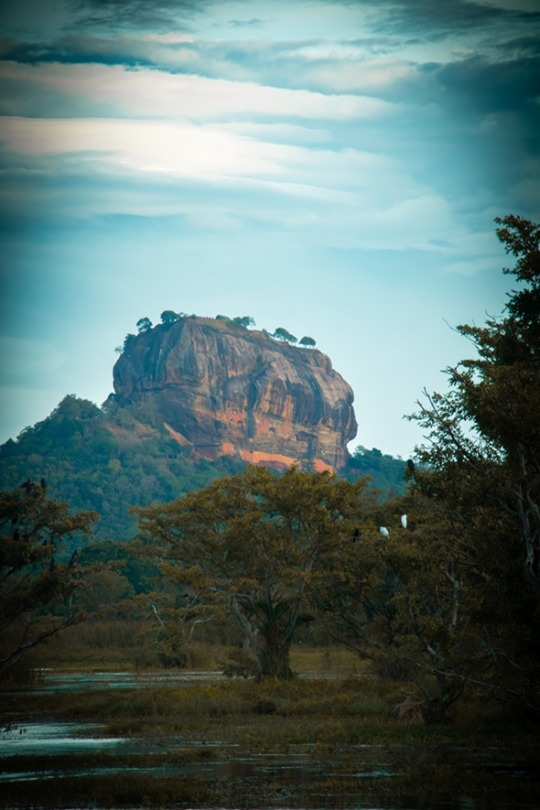
Rising majestically from the jungle, Sigiriya is a UNESCO World Heritage Site and one of Sri Lanka’s most iconic landmarks. The climb to the summit offers breathtaking views of the surrounding forests, home to macaques, monitor lizards, and vibrant birdlife.
Anuradhapura Sacred City One of the oldest endlessly inhabited cities in the world, Anuradhapura is surrounded by sprawling gardens and reservoirs that attract migratory birds and local wildlife. The sacred Bodhi Tree and ancient stupas add a spiritual touch to the natural beauty.
Polonnaruwa Ancient City Polonnaruwa’s well-preserved ruins are set against a backdrop of serene landscapes. The nearby Minneriya National Park offers the chance to witness the spectacular elephant gatherings, blending history with an unforgettable wildlife encounter.
Dambulla Cave Temple

Perched on a hill, this series of ancient caves features stunning Buddhist murals and statues. The area is rich with flora and fauna, with langurs often seen playing among the trees.
Ritigala Monastery Hidden deep within a forest reserve, Ritigala is an ancient monastery shrouded in mystery. The lush greenery and tranquil atmosphere make it a haven for nature enthusiasts and history buffs alike.
With Nature Voyage, your adventure seamlessly blends exploration, education, and luxury. Their tailored itineraries for Sri Lanka Adventure Holidays ensure you experience the best of the island’s ancient heritage while immersing yourself in its natural beauty.
Expert Guides: Learn fascinating stories about ancient sites and their connection to local ecosystems.
Custom Adventures: From wildlife safaris to guided historical tours, every journey is designed to suit your interests.
Eco-Friendly Practices: Nature Voyage emphasizes sustainability, ensuring minimal impact on these cherished sites and their surroundings.
Sri Lanka’s ancient sites are more than just relics of the past—they are vibrant connections where history and nature come alive. With Nature Voyage, you can uncover these treasures while immersing yourself in the wild beauty of the island. Whether you’re trekking through dense jungles, climbing iconic rock fortresses, or marveling at ancient ruins, this journey promises an unforgettable blend of culture and adventure.
0 notes
Link
0 notes
Text
Top 10 Must-Visit Tourist Places in Haridwar
Haridwar, a city steeped in spirituality and tradition, is one of the most revered destinations in India. Nestled on the banks of the holy Ganges River, Haridwar offers a perfect blend of religious significance and natural beauty. If you're planning a trip to this sacred city, here are the top 10 must-visit Haridwar tourist places that should be on your itinerary.
1. Har Ki Pauri
Har Ki Pauri is the most famous ghat in Haridwar, attracting thousands of pilgrims every day. This sacred spot is where devotees gather to take a holy dip in the Ganges, believing it will wash away their sins. The evening Ganga Aarti at Har Ki Pauri is a mesmerizing spectacle that should not be missed.
2. Chandi Devi Temple
Perched on the Neel Parvat of the Shivalik Hills, the Chandi Devi Temple is one of the most important Haridwar tourist places. This ancient temple, dedicated to Goddess Chandi, offers stunning views of the city and the surrounding landscape. You can either trek up to the temple or take a cable car ride for a scenic journey.
3. Mansa Devi Temple
Another significant religious site in Haridwar is the Mansa Devi Temple, located atop the Bilwa Parvat. This temple is dedicated to Goddess Mansa Devi, who is believed to grant the wishes of her devotees. The temple is accessible via a ropeway or a steep climb, and it provides a panoramic view of Haridwar.
4. Maya Devi Temple
The Maya Devi Temple is one of the three Siddh Peethas in Haridwar, making it a crucial pilgrimage site. Dedicated to Goddess Maya Devi, this temple holds great religious significance and is one of the oldest in the city. A visit to this temple is a must for anyone exploring Haridwar tourist places.
5. Sapt Rishi Ashram
Sapt Rishi Ashram is a tranquil spot where seven great sages, or rishis, are said to have meditated. Located at the confluence of the Ganga and Yamuna rivers, this serene ashram is a perfect retreat for those seeking peace and spiritual rejuvenation.
6. Bharat Mata Mandir
The Bharat Mata Mandir is a unique temple dedicated to Mother India. Unlike other temples in Haridwar, this one does not honor any specific deity but instead celebrates the nation. The temple has eight floors, each depicting different aspects of Indian culture, history, and spirituality.
7. Patanjali Yogpeeth
Founded by the renowned yoga guru Baba Ramdev, Patanjali Yogpeeth is one of the largest yoga institutes in the world. It is a major attraction among Haridwar tourist places, especially for those interested in yoga and Ayurveda. The institute also offers a range of Ayurvedic treatments and therapies.
8. Daksha Mahadev Temple
Located in Kankhal, a small town near Haridwar, the Daksha Mahadev Temple is an ancient shrine dedicated to Lord Shiva. This temple is closely associated with the mythology of Sati and is one of the most important Haridwar tourist places for Shiva devotees.
9. Rajaji National Park
For nature lovers, Rajaji National Park offers a refreshing escape from the spiritual aura of Haridwar. Spread over 820 square kilometers, this national park is home to a diverse range of wildlife, including elephants, tigers, and leopards. A jeep safari through the park is a thrilling experience for adventure enthusiasts.
10. Neel Dhara Pakshi Vihar
Birdwatchers will find Neel Dhara Pakshi Vihar a paradise. Located at the Bhimgoda Barrage, this bird sanctuary is home to several migratory birds, especially during the winter months. It's one of the lesser-known Haridwar tourist places, making it a peaceful spot for nature lovers.
Conclusion
Haridwar is a city that offers a spiritual retreat, cultural richness, and natural beauty all in one. These top 10 Haridwar tourist places are a testament to the city’s diverse attractions, making it a must-visit destination for travelers. Whether you're seeking spiritual enlightenment or a peaceful escape, Haridwar has something for everyone.
For an unforgettable journey through these sacred and scenic spots, consider booking your trip with haridwartourtrip. They offer curated experiences that will help you explore the best of Haridwar with ease and comfort.
#Chardham Yatra Package From Haridwar#char dham yatra package from Delhi#Char dham yatra package#Haridwar Tourist Places
0 notes
Text
Different Ski Disciplines to Consider
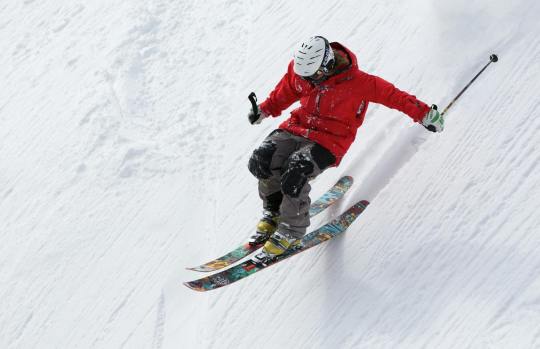
According to the National Ski Areas Association (NSAA), more than 60.4 million American skiers visited ski resorts during the 2023/2024 season. The data marks a slight decrease from the 2021/2022 and 2022/2023 winter seasons, the two biggest ski seasons in American history. Skiing is a popular outdoor activity in several regions of the United States, from the Pacific Southwest to the Northeast. Individuals interested in participating in skiing for the first time should know that there are several different skiing styles to choose from.
American skiers have excelled internationally, trailing only Austria and Switzerland at the Winter Olympics with 47 medals, including 17 gold medals. As one of the oldest recorded athletic activities, the first instruments used to ski stem from Northern China more than 8,000 years before the Common Era. Research suggests humans were using skis during the most recent Ice Age. Alpine skiing, or downhill skiing, is a much more modern concept, originating in the Norwegian army during the 18th Century. The following centuries saw an expansion of skiing styles for various purposes, including athletic competition and recreation.
Alpine skiing remains the most popular discipline. Most facilities and trails at ski resorts and mountains cater to the needs of alpine skiers and snowboarders. Individuals participate in alpine skiing by riding a chairlift to the top of a run and skiing to the bottom of the mountain. Gaining momentum while traveling downhill gives skiers a rush of adrenaline while also providing considerable cardiovascular exercise. The highest summit for alpine skiing in the US is at Silverton Mountain in Colorado, at 13,487 feet.
Individuals can also participate in backcountry skiing, which some view as the opposite of alpine skiing. Backcountry skiing generally occurs in remote regions beyond the boundaries marked by mainstream resorts and mountains. Backcountry skiers do not ski down well-maintained trails and may need to engage in hiking and snowshoeing at times.
Next, backcountry skiing differs from cross-country skiing, though the two disciplines share similarities. The major difference is that cross-country skiers seek out large stretches of clear, flat terrain. Cross-country skiing is more about traveling long distances, while backcountry skiers push their physical limits by switching between downhill, cross-country, and uphill skiing.
Uphill skiing, also called skinning and alpine touring, is a physically challenging activity that involves climbing steep hills using various equipment. In addition to skis and poles, individuals wear special boots and use hiking gear. Uphill skiers usually switch out their gear at the top of a mountain for their alpine skiing equipment and ski to the bottom of the run they just climbed for convenience.
Additional styles of skiing to consider include telemark skiing and ski mountaineering. Telemark skiing is about style and technique. Individuals assume a specific crouched position while skiing, which requires skiers to implement different skills, especially while turning. Ski mountaineering, meanwhile, is comparable to backcountry skiing and alpine touring. The difference is that ski mountaineers often integrate skiing with hiking and camping and may spend several days skiing in the wilderness.
0 notes
Link
0 notes
Video
92 - Austin Mini Ritz - Simon Cox par Andrew C. Noble
#British Hilll Climb Championship#Canon EOS 7D MK2#Championship Challenge#EOS#Hill Climb Leaders Championship#Intensify Pro#MAC#MSA British Hill Climb Championship#MSA#Macphun#National Hill Climb Association#SHELSLEY WALSH#Speed Hill Climb#SBD HSA#Austin MIni#C920UDG#Simon Cox
3 notes
·
View notes
Text
prompt #1 | prompt #2 | prompt #3 | prompt #4 | prompt #5 | prompt #6 | prompt #7 | prompt #8 | prompt #9
expanded prompts: Hygge on AO3
prompt #10: been a while since someone met me in the middle (Feels So Easy by Ber)
ie. been stuck home with COVID for a week and I’m comforting myself with really mushy kid!fic and this song on repeat
October 2030
“Nuh uh,” Beatrice harrumphs, kicking at the back of the driver’s seat with her shoe.
“Yeah huh,” Andrea retaliates.
They’ve been at each other’s throats since the moment Maya had picked them up from school. Bickering over who was going to sit where in the car and what was for snack and now, apparently, something else.
Maya sighs as she climbs into the front seat, the groceries secure in the trunk and the cart back where it belongs. She’d taken it to a cart return a little further away than necessary if she’s being honest, if only for a few extra minutes of peace from the constant nitpicking.
Even in the store, where they would normally be on their best behaviour, they’d managed to argue and fight until finally Maya had snapped at them. They’re undeterred though, it seems; hellbent on pushing each other’s buttons until everyone around them goes mad.
“No,” Beatrice repeats, spitting the word with all the force her five-year-old rage can muster, “She does not.”
“She does!” Andrea shouts right back, “You don’t know everything, Bea.” He huffs with frustration, folding his arms across his chest like some sort of barricade against his sister’s blows. It does little to help, though.
Beatrice’s eyes go wide, her fists balling up tight, and her next words come out in a holler. “Mama. Does. Not!”
“Woah, woah, woah,” Maya interrupts, turning around in the driver’s seat to stare them down. “That’s enough, both of you. Either make up or quit talking to each other.”
Beatrice frowns, shaking her head. “Andrea is mean,” she whines, “And it hurts my feelings.”
“No,” he argues, sitting up straighter in his seat, “Telling the truth is not being mean, Bea!”
“It’s mean to Mama,” Beatrice howls.
“Enough!” Maya yells, silencing them both. “How do you have anything left to fight about?”
“Andrea says Mama has an accent,” Beatrice tells her then, brows furrowed together into a harsh line above her eyes. “That’s not nice.”
Andrea groans and shakes his head, clearly baffled that this is the hill his little sister is willing to die on. “Mama does have an accent, she’s Italian.”
“We’re all Italian,” Beatrice bites back.
“No,” Andrea corrects again, “Mommy isn’t Italian.”
Beatrice gasps, apparently affronted, and whirls to look at Maya. “See, Mommy?” she cries, her bottom lip pushing its way into a pout, “Andrea is mean.”
It’s a common feeling as a parent, Maya’s found; being both frustrated by your children and wanting to laugh at them. She watches, biting her tongue, as Andrea throws his head back against the seat and sighs with far more exasperation than a seven-year-old should contain. Beatrice, seated beside him, looks lost somewhere between a fit of rage and the welling of tears, desperate to defend her beloved Mama.
“Bea,” Maya tries, swallowing roughly around the laugh threatening to escape, “Do you know what an accent is?”
Little wisps of blonde hair bounce around Beatrice’s face as she nods, ponytail swishing against the back of her booster seat. “It’s when someone talks funny,” she says, shooting Andrea an angry glare at the same time, “But Mama doesn’t.”
“That’s not what it means,” Andrea disagrees, “It’s a mode of pronunciation!”
There’s a familiar look on Andrea’s face when Maya glances over at him, one she’s seen flit across Carina’s a million times over. He’s quoting something he’s read, she knows, repeating verbatim the bit of information he’s absorbed into that pliable brain of his.
She can recite the rest of the definition herself this time, though; they’d looked it up together while working on his family tree assignment over the weekend. Especially one associated with a particular nation, locality, or social class.
“Like Mama?” he’d asked. “Because she grew up in Italy?”
Of course he’d want to teach his little sister.
Beatrice scoffs. “You’re a mode of pronunciation, ‘Drea.”
“Alright, alright,” Maya says before they can unravel into name calling… again. “No more talking to each other until we’re home.”
“But –” Andrea starts.
“No,” Maya cuts him off, turning back towards the steering wheel, “If we’re all stuck together for ten more minutes, they’re going to be silent minutes.”
~
Carina is already home by the time they get there, freshly showered and sprawled across the couch with her damp hair slung over the arm. She abandons her phone on the coffee table when the front door opens and the kids barrel through, lifting her arms in invitation for their hugs.
For once, it’s Andrea that gets to her side first, kicking off his shoes and dropping his school bag in favour of folding himself into his mother’s embrace. He sighs as she kisses the side of his head, the weight of the day rolling through his limbs.
“Sole,” Carina coos, burying her fingers in his dark, curly hair, “Com’era la scuola?” (How was school?)
Maya moves past them, heading for the kitchen island with the bags of groceries. She knows what’s coming, though – knows the ten minutes of quiet in the car on the drive home have only added fuel to the fire of Beatrice’s fury.
It arrives with the stomp of little feet.
Carina, at least, appears startled when she looks up to find Beatrice standing with her arms folded, scowling at her brother.
“You don’t get to hug Mama when you’re mean, Andrea,” Beatrice pouts, stomping her foot again with a surge of frustration. “You are not nice!”
A moment of silence passes through the living area, everyone apparently assessing the situation. Carina’s eyes dart up over the back of the couch, catching Maya’s gaze from across the island, clearly seeking some sort of explanation. Maya can only bite back another laugh, though, turning towards the fridge to put the groceries away.
Andrea sighs with defeat, extracting himself from Carina’s hold so he can sit up. The day is so clearly heavy on his shoulders, weighing down the edges of his mouth. “I wasn’t mean, Mama,” he murmurs, “I promise.”
Carina’s fingers trail across his cheek, her head bobbing as she nods her understanding.
Beatrice, however, is still having none of it. “You were!” she screeches, “You were mean to Mama and you have to go to your room!” She stomps her feet again, thudding them against the tile floor so hard the door rattles in its frame. “Say! Sorry!”
Again, the house falls silent. Maya turns just in time to see Carina sit up, Andrea shuffling out of the way as she swings her legs over the side of the couch. Beatrice reacts as she usually does at first: shoulders hiking up around her ears in fear as she attempts to stand her ground.
“Beatrice Lucia,” Carina says so softly that Maya has to strain her ears to catch it, “Do we yell?”
A tiny chin juts out, their little girl not yet ready to give up the fight. “No,” she mumbles, “But –”
“Basta,” Carina cuts her off, “Do we stomp our feet?”
Beatrice’s frown gets deeper as she shakes her head.
“Do we behave like this?” Carina continues, “Or do we take a deep breath and try again?”
In an instant, Beatrice’s eyes go glassy and she shudders through a slow breath, biting down hard on her bottom lip as the tears begin to dribble down her cheeks. She kicks softly at the floor, hands linking together in front of herself.
And Carina, as always, softens just as quickly. “Vieni qui,” she whispers, holding her arms open for Beatrice to collapse into. She rocks their daughter slowly, rubbing her back gently, as the well of emotion she’s been feeling spills over.
Andrea reaches for Beatrice, too, laying his hand over top of hers where it rests on Carina’s thigh.
Not for the first time, Maya finds herself struck immobile in the face of the stability their children find in Carina’s arms. Years of her own therapy have still left her walled off to their emotions at times. Hell, she’s spent the last hour with them wishing they would stop bickering and yet five minutes home in their mama’s presence has been enough for them both to shed what was making them so miserable to each other.
She crosses the kitchen and into the living room, taking up residence on Andrea’s other side so he can lean against her. “Andrea was teaching us about accents in the car,” she tries as helpfully as she can manage, watching as the word makes Beatrice tense again, “And Bea was very upset that we said you have an accent.”
Carina catches her eye at the words, left eyebrow rising sharply.
Andrea nods, pressing his body tighter against Maya’s. His hand lifts from Beatrice’s and falls back into his lap. “Because an accent is a mode of pronunciation,” he mumbles, “And you grew up in Italy.”
“Si,” Carina nods, “I did.” She strokes her hand gently down Beatrice’s back again, kissing the side of her temple before she speaks. “I do have an Italian accent. Just as you all have American accents.”
Beatrice pushes away from her then, staring up at Carina with confusion. “That doesn’t hurt your feelings?” she asks.
Carina chuckles, reaching up to smooth the wisps of blonde hair back from Beatrice’s cheeks. She shakes her head.
Beatrice frowns, looking over at Andrea. She purses her lips, clearly thinking.
He seems to know what she’s going to say before she can string the words together. “It doesn’t mean someone talks funny.”
“Is that why you thought he was being mean?” Carina whispers. Her fingers wander as she asks, finding Andrea’s cheek and curling around it.
“I’m sorry,” Beatrice murmurs. Her eyes, still glassy, dart from Carina’s face to Andrea’s, something tugging at the corners of her mouth. “You’re not mean, ‘Drea.”
He nods. “Com’era la scuola, Bea?” (How was school, Bea?)
She sighs at the question, leaning all of her weight into Carina’s arms. “Mi è mancata la mamma e mommy.” (I missed Mama and Mommy.)
It’s a phrase she’s been uttering a lot the last month, adjusting to the new routine of being away at school all day long. The hospital daycare is no longer a part of her schedule but she’s not yet old enough to find Andrea at recess on the playground. Their little girl, for the first time in her life, is separated from them all for much of her day. And rightfully so, she’s struggling.
Maya exhales slowly, letting her eyes drift up to Carina’s in understanding. Carina, who is the stable place their children land when emotions are troubling. Carina, who sees their horrible and somehow still recognizes the reasons behind it. Carina, who does all the things for their family that Maya is still learning to do for herself.
Carina’s face breaks into a grin and then she tips, taking Beatrice with her as she dogpiles their kids into a hug that lands them forcefully in Maya’s lap, squeezed together with loud, smacking kisses. She travels as she pecks at them: one on Beatrice’s head, another on Andrea’s cheek, the third on Maya’s lips.
Maya smiles as they finally connect, reeling her wife back in for just one more.
“Thank you,” she whispers above their children’s heads, their giggles punctuating the sentiment. “We’d be so lost without you.”
#call this 1900 words of i'm sad i have covid#its really shit my apologies#but apparently it still feels like a hug so have at it#i didn't double check the italian with my resident expert so also sorry for that#tags are for apologizing tonight??? stopping now#minefic#hygge universe#maya x carina fic#carina x maya fic#marina fic#prompt party
30 notes
·
View notes
Text
The Land of Smiles: Must-Visit Destinations in Thailand
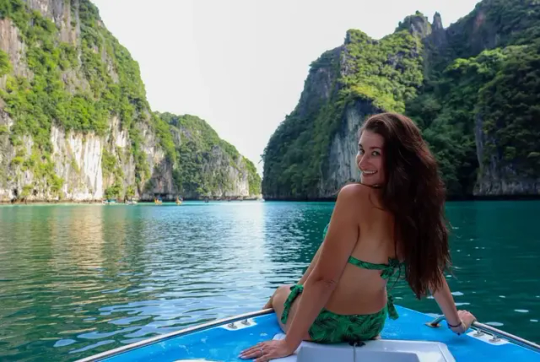
Thailand, often called “The Land of Smiles,” is a country that effortlessly combines breathtaking natural beauty, rich cultural heritage, and vibrant modernity. With its warm hospitality, diverse landscapes, and myriad attractions, Thailand is a dream destination for all types of travelers. Whether you're drawn to the pristine beaches of the south, the lush jungles of the north, or the bustling streets of Bangkok, Thailand offers an experience like no other.
Bangkok: The Vibrant Heart of Thailand
As Thailand’s capital, Bangkok is a city that never sleeps. A dynamic metropolis, it seamlessly blends traditional culture with contemporary living.
Temples and Landmarks
Bangkok is home to some of the country���s most iconic temples. The Grand Palace, a symbol of Thai royalty, dazzles with its intricate architecture and the revered Emerald Buddha. Nearby, Wat Pho houses the magnificent Reclining Buddha and is a hub for traditional Thai massage. For a scenic temple experience, visit Wat Arun (Temple of the Dawn), which is especially stunning during sunset.
Shopping and Nightlife
Bangkok offers endless shopping opportunities, from the high-end malls of Siam Paragon and CentralWorld to the bustling street markets of Chatuchak Weekend Market. At night, the city comes alive with rooftop bars, nightclubs, and vibrant street food scenes in areas like Khao San Road and Sukhumvit.
Chiang Mai: A Cultural and Spiritual Haven
Nestled in the mountainous region of northern Thailand, Chiang Mai is a stark contrast to Bangkok’s bustling pace. Known for its ancient temples, serene atmosphere, and thriving arts scene, it’s a must-visit for those seeking a deeper connection with Thai culture.
Temples and Heritage
Chiang Mai boasts over 300 temples, each with its unique charm. Wat Phra That Doi Suthep, perched on a hill overlooking the city, is one of the most significant temples in Thailand. Its golden stupa and panoramic views are unforgettable. The Old City area is dotted with historic temples like Wat Chedi Luang and Wat Phra Singh.
Adventure and Nature
For the adventurous, Chiang Mai offers activities like trekking through lush forests, visiting elephant sanctuaries, and exploring hill tribe villages. The Doi Inthanon National Park, home to Thailand’s highest peak, is perfect for nature lovers.
Phuket: The Pearl of the Andaman
Phuket, Thailand’s largest island, is famous for its stunning beaches, vibrant nightlife, and luxury resorts. It’s a hub for beach lovers and water sports enthusiasts.
Beaches and Water Activities
From the lively Patong Beach to the tranquil shores of Nai Harn, Phuket offers a beach for every traveler. Activities like snorkeling, diving, and jet-skiing are widely available. The nearby Phi Phi Islands and Similan Islands are world-renowned for their crystal-clear waters and vibrant marine life.
Nightlife and Entertainment
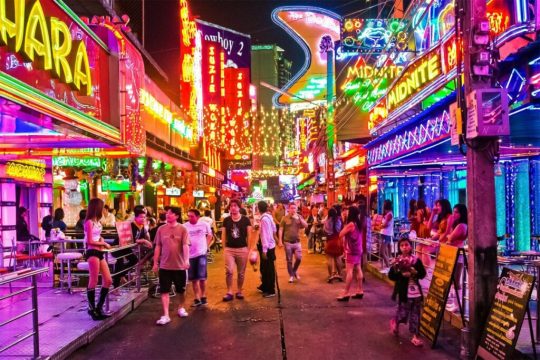
Phuket’s nightlife is legendary. Bangla Road in Patong transforms into a lively party street after dark, filled with bars, clubs, and street performers. For a more cultural experience, the Phuket FantaSea show offers a spectacular blend of Thai traditions and modern entertainment.
Krabi: Nature’s Masterpiece
Krabi is a haven for those seeking dramatic landscapes and serene beaches. Its unique limestone cliffs, emerald waters, and hidden caves make it a photographer’s paradise.
Ao Nang and Railay Beach
Ao Nang serves as the main hub, offering a range of accommodations and access to nearby attractions. Railay Beach, accessible only by boat, is a slice of paradise known for its rock climbing and breathtaking views.
Island-Hopping Adventures
Krabi is the gateway to some of Thailand’s most beautiful islands, including Koh Lanta and Koh Phi Phi. The famous Four Islands Tour takes you to pristine spots like Phra Nang Cave Beach, Tup Island, and Chicken Island.
Pattaya: More Than Just Nightlife
Pattaya, often associated with its vibrant nightlife, has much more to offer for families and travelers.
Cultural Experiences
The Sanctuary of Truth, a massive wooden structure intricately carved with religious and philosophical motifs, is a must-see. Nong Nooch Tropical Garden showcases stunning landscapes and cultural shows.
Adventure and Fun
For adventure seekers, Pattaya offers water sports, zip-lining, and go-karting. Families can enjoy attractions like the Cartoon Network Amazone Waterpark and Pattaya Dolphin World.
Ayutthaya: A Glimpse into Thailand’s Glorious Past
Ayutthaya, a UNESCO World Heritage Site, was once the capital of Siam. It’s a treasure trove of ancient temples and ruins, reflecting the grandeur of its past.
Historic Sites
The Ayutthaya Historical Park is home to iconic sites like Wat Mahathat, famous for the Buddha head entwined in tree roots, and Wat Chaiwatthanaram, known for its striking Khmer-style architecture. Exploring the ruins by bicycle is a popular way to soak in the history.
Pai: A Tranquil Retreat in Northern Thailand
For those seeking peace and natural beauty, Pai is a hidden gem. This small town is surrounded by lush valleys, waterfalls, and hot springs.
Natural Wonders
Pai Canyon offers stunning views of the surrounding landscapes, while the Pai Hot Springs are perfect for a relaxing soak. The Land Split, a natural geological phenomenon, is an interesting stop with a unique backstory.
Cultural Charm
Pai’s walking street comes alive in the evenings with local crafts, street food, and live music. The Yunnan Cultural Village offers insights into the lives of Chinese communities in the region.
Koh Samui: An Island Paradise
Koh Samui combines luxury with natural beauty. Known for its palm-fringed beaches, upscale resorts, and wellness retreats, it’s an ideal destination for relaxation and rejuvenation.
Beaches and Waterfalls
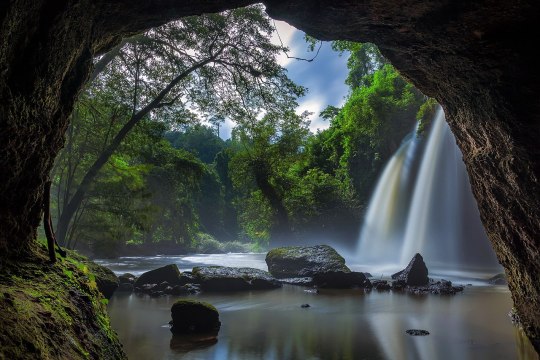
Chaweng and Lamai are the most popular beaches, offering water sports and vibrant nightlife. For a quieter experience, head to Maenam or Bophut. The island’s waterfalls, like Na Muang and Hin Lad, are also worth exploring.
Cultural Attractions
The Big Buddha Temple and Wat Plai Laem are iconic landmarks that offer a glimpse into the island’s spiritual side.
Conclusion: Thailand Awaits Your Exploration
Thailand’s diverse attractions make it a destination for every traveler. Whether you’re drawn to the cultural richness of Chiang Mai, the urban energy of Bangkok, or the serene beaches of Krabi, the Land of Smiles promises unforgettable experiences. Pack your bags and embark on a journey that blends culture, nature, and adventure in one incredible destination.
#TravelThailand#ThailandAdventures#ExploreThailand#LandOfSmiles#ThailandBeaches#BangkokCityLife#ChiangMaiCulture#PhuketParadise#KrabiDreamscape#PattayaExploration#AyutthayaHistory#PaiNatureEscape#KohSamuiLuxury#IslandHoppingThailand#ThaiStreetFood#TempleTourThailand#BackpackingThailand#ThailandBucketList#NatureInThailand#CulturalThailand#AdventureThailand#HiddenGemsThailand#ThailandTravelTips#DiscoverThailand#ThaiExperience
0 notes
Photo
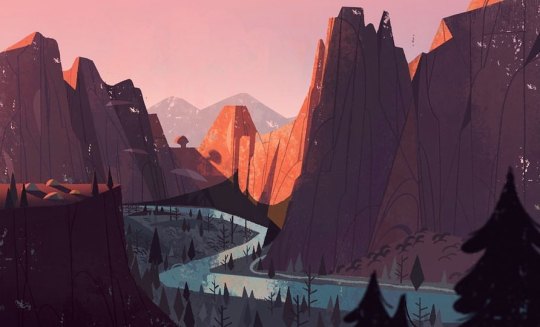
⭐️ Special Edition Print! ⭐️ I’m excited to announce I’ve partnered with the @thelandmarkproject to release a limited month-long print run of my Smith Rock illustration. 💯 percent of the proceeds go to the National Parks Conservation Association which strives to protect and preserve our nations most iconic and inspirational places for present and future generations. They celebrate the parks, and work tirelessly to defend them, whether on the ground, in the courtroom or on Capitol Hill. @thelandmarkproject also did an interview with me which is live on their website! (Link in bio!) 🌲 🍄 thanks for your support and for loving your parks! @smithrockstatepark @npca_advocate @thelandmarkproject #illustration #nationalparks #smithrock #climbing https://www.instagram.com/p/CR7C8d6LrS9/?utm_medium=tumblr
177 notes
·
View notes
Text
Rachel + Leah + Water, the Director’s Cut!
Okay, so I made this gifset exploring Rachel and Leah and the ocean, but because there’s a ten gif limit and a major point of gifsets is for them to look nice, I had to sacrifice a lot of the behind the scenes thoughts and initial versions that came along the way. I still wanted to talk about them though, because I found a lot of them really cool, so I figured I’d stick all that in this post. It’s gonna get long, so you can find the rest under the cut!
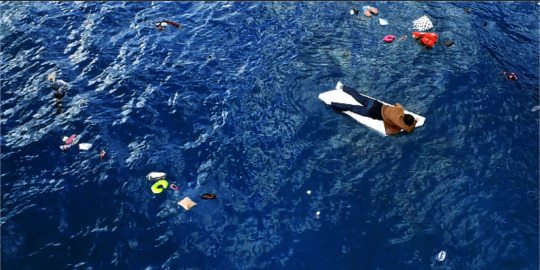
So first up, we have Leah as we first see her in the water. (I’m using shitty screenshots because tumblr has a 2mb limit for gifs on text posts and I don’t feel like compressing these down lmao.) Here, she’s face-down, unconscious, floating on a fragment of the plane. This is the first time we see any of the girls in the water.
As Leah gives her dramatic speech talks to the detectives, we see flashbacks to the girl’s lives pre-island. There we see that one of them already has a very strong relationship with the water already, in her before-life: Rachel.
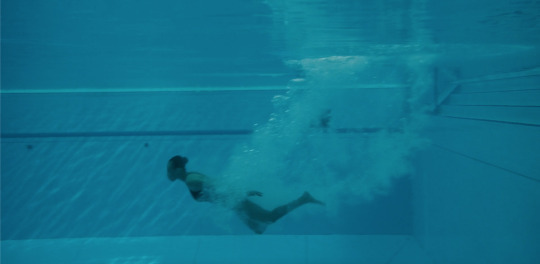
Rachel, as we know, is a diver. We see her take a magnificent tumble into the pool, but when she surfaces, her coach is sternly head-shaking. She corrects Rachel’s form, and after she walks away, Rachel echoes the correction, clearly frustrated with herself.
Back to Leah. We next see Leah waking up on her lil chunk of flotsam. When she realizes what the hell’s going on, she does what we all would do and starts screaming in terror.
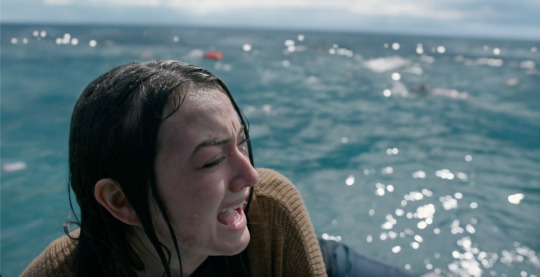
Her panic gets interrupted by Jeannette’s classic Raise Your Glass ringtone. (This was my alarm for two years in high school, and when I watched this for the first time I did have an out-of-body experience). She swims her way over to the Hello Kitty suitcase and—irrationally—unzips it, but we’ll cut her some slack because she’s in some serious shock. As she tries to get the phone, it slips through her fingers and starts spiraling down to the bottom of the ocean. She dives after it.
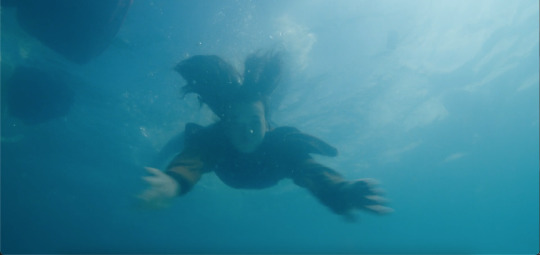
Unfortunately, she quickly runs out of air and has to give up. She then spots Jeannette floating nearby, checks her out, judges her to be “just a little roughed up,” and then sees land and has a big oh-thank-fuck moment. Because we saw Gretchen’s team placing all of the girls, we know that Linh and Leah were the only two that were put out in the open water. The other girls were put in the beach, or, in Martha’s case, near the shore. This was probably done to quell some of Leah’s suspicions about the crash, but it does give me a couple questions about how they got the other girls wet—did they hose them all down? Pour a couple buckets over their heads? Bob each of them up and down a couple times in a big net like fries in a fryer??
Anyway, not important.
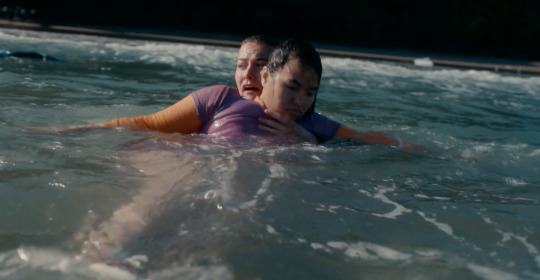
Next that we see, Leah has pulled Jeannette/Linh in from the water. (My Australian parents, who can never pass up an opportunity to give ocean safety tips, chimed in at this point in our first watch to say “See how she’s doing it! You always want to hold someone from behind and pull them in that way. Good job, well done.” So there’s some approval for you, Leah.) As Leah nears the shore, Dot and Toni come tearing in and they help pull the two of them out.
The rest of the episode after that really only concerns fresh water—Toni and Shelby set out in search of it, to no avail, and Nora helpfully plugs Diet Coke reminds us multiple times that sugar’s heavier than water, so “sugar sinks.” We do set up a goal for the next couple episodes, though: Rachel says, “I'm gonna swim out to the plane tomorrow. See if I can find anything,” and Leah volunteers to come with. Rachel gives her a nod of respect.
Moving on to episode two, we have Rachel and Leah’s (iconic) first real conversation. Rachel says she’s still going out to the wreckage. Leah looks out and looks back at her, incredulous, and says, “Rachel, the water’s insane.” Here’s a big recurring association—the water and “insanity.” (I use insanity here because that’s the language they use, along with psycho/crazy. In no way does that reflect my actual beliefs about their behavior nor am I condoning the way they use those words.) Leah points out the rip current (“well done,” said my mum), and explains her very brief stint as a norcal surfer. Rachel still looks set on going, but then Leah says:
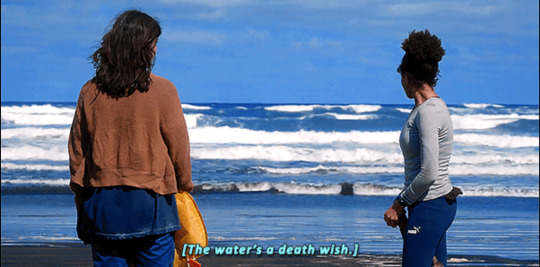
Turns out, Leah can be as ripe with foreshadowing as Fatin. This marks the appearance of their second main association with the ocean—death. After she says this, Leah turns Rachel’s attention inland, and the two agree to climb a big hill to scope out their situation.
Episode two is also obviously Rachel’s episode, so we see a lot of her relationship with diving.
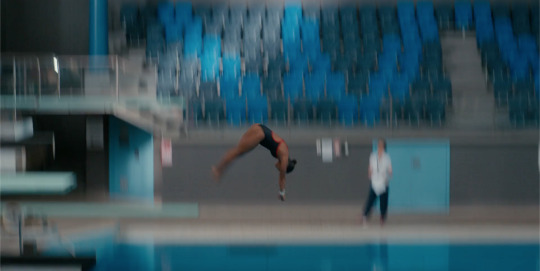
We see her plunge over and over and over again, drilling technique and form, but despite all her hard work, we learn her coach advised her to quit the team. Instead, Rachel throws herself in twice as hard, and ends up with an eating disorder. By the time the nationals come around, she’s too physically weak to dive safely, and she ends up hitting her head as she goes down. She surfaces in the pool with blood flowing around her.
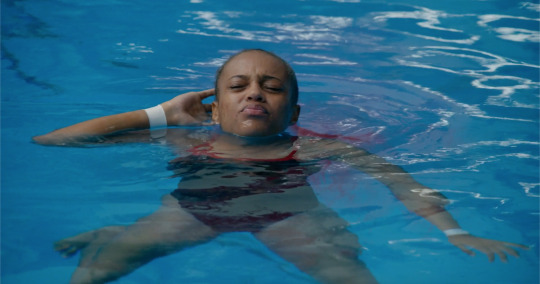
She refuses to see that as the end of her diving career. She says she’s gonna “get back out there” and “be fucking great again” and she tells Nora at the end of the episode that she needs her to let her believe that.
In episode three, we finally see Leah and Rachel’s trip out to the plane! Nora comes along with them, her relationship with Rachel smoothed over after the events of ep two. “Nora’s a good swimmer,” Rachel explains as she invites her, “We were both water babies.” Water’s clearly been central to Nora and Rachel’s identities since they were really young.
The three of them make their escape from the rest of the girls as the topic of building a shelter comes up. “Not interested in putting down roots!” Rachel calls. In keeping with the elements theme, Rachel isn’t looking to be grounded. She climbs super high into the air and she dives deep into the water, but earth isn’t her thing. (See: the quicksand scene. Whoops.)

Anyway, the three of them paddle out into the water. Rachel dives down, scopes out the plane, tells Nora she doesn’t expect her to “fucking free dive in open water,” and then looks to Leah and asks if she’s ready. Leah reluctantly agrees.
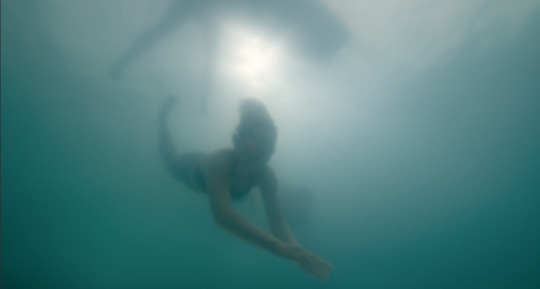
We get our first shot Rachel swimming down into the ocean and our second shot of Leah (first the phone, second the plane). In the wreckage of the plane, they discover the black box, affixed to the wall. They keep trying to wrench it free, but it’s stuck, and Leah—who’s primary activity is, like, reading—keeps having to surface for air. Rachel gets frustrated and grabs her leg, holding her down.
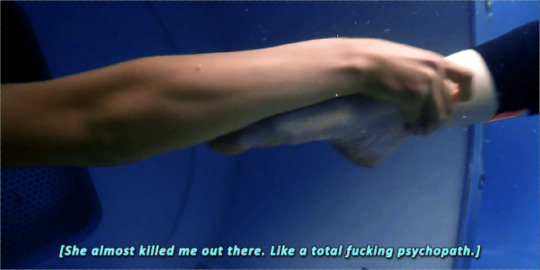
Leah screams and fights, but Rachel doesn’t let go. We cut away, and when we see them again, they’ve emerged victorious (Rachel) and drowned as dogs after a bath (Leah and Nora) with the black box in hand. Later, Leah mutters the above line to Fatin, calling Rachel a “psychopath.” For those keeping score at home, here’s where we refer back to the association between water and “insanity.”
In episode four, the ocean benevolently bestows a bag of takis upon Nora, and we have our whole shelter-building shebang. It’s all very land-based until Leah and Fatin go head to head, which ends with Fatin smearing her blood all over Leah’s face. Leah, with her usual flair, strips off her clothes as she walks into the ocean. She stays down there, passively letting the water wash the blood from her face.
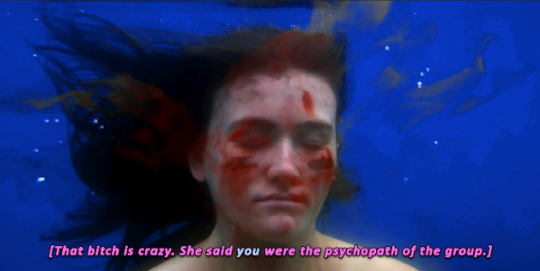
This shot parallels a couple things. First, the drifting blood visually parallels Rachel in the pool after her diving injury. Second, we have Rachel staring out at the water where Leah’s disappeared and going, “Man, that is some real Virginia Woolf-type shit.” Dot has no fucking clue what she means, so Fatin interprets: “It means that bitch is crazy. She said you were the psychopath of the group.” Now it’s Leah who’s done something in the water that’s been deemed insane. The water and “insanity;” the water and accusations of insanity within their relationship.
Those accusations pop up in episode five, but the episode is pretty focused on the inland search for Fatin, and revolves around fresh water, not salt water. (That could be a whole nother post lol.) It’s in episode six where we again see these two return to the ocean.
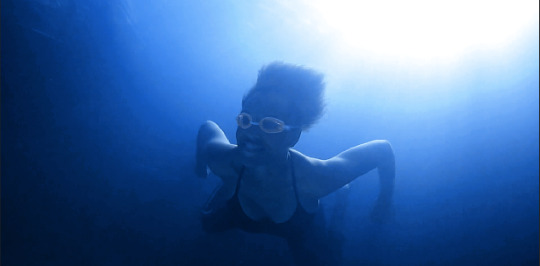
Rachel is diving in the ocean! For fun! She’s picking up pretty shells (which granted isn’t the safest thing to do in the pacific, cone snails are not our friends), and she’s grinning, and she’s generally enjoying herself. With the, uh, finale situation, we’re probably not gonna get to see her smile for a bit, which is sad, because she should get to do this more often! This shot visually echoes her diving for the plane and Leah diving for the phone, except she can be in a better mood because there is no end goal.
So she goes diving, ends up finding a bunch of mussels, gathers ‘em up, and brings ‘em back to camp. They all chow down, but wind up with serious food poisoning. Martha and Toni ring death’s doorbell a couple of times. Rachel blames herself—she’s the one that went swimming out there, she brought the mussels back. Again, we see that connection between the ocean and death.
And that association comes back bright an early in ep seven! The tide surges higher than they’ve ever seen, taking down their shelter and leaving them all scrambling.
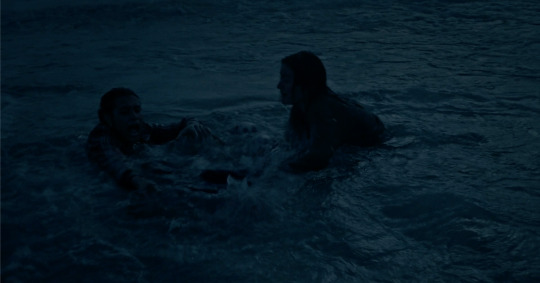
While Leah convinces Fatin that her life is more important than her suitcase, Rachel is left with a decision: help Nora, screaming to her from where she’s clinging to a rock for dear life, or grab the black box. In a move that contrasts Toni’s immediate and unquestioning aid of Martha, Rachel picks the black box.
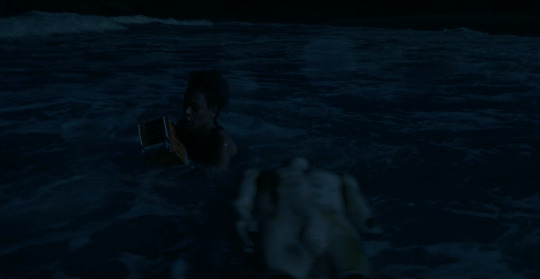
After, when they’re debriefing, Nora’s quick to bring it up. She doesn’t hide her hurt. “It happened so fast,” she says, “we all acted irrationally. Like Fatin, who jumped into a rip current to save her toothbrush. Or Rachel, who left me for fucking dead.” I think this counts as a double whammy for the “insanity” and death count—I think “acted irrationally” is as close as Nora gets to calling anyone crazy, and is honestly a better descriptor of all the other instances of “insanity” that we’ve seen, and the ocean was the source of the very real risk to Nora’s life.
(Honestly, I think Rachel thought she was making a rational choice here—just with some grim fucking calculus. Still, given that nobody’d responded to the black box by then, I think it was a decision fueled by the need to keep hold of hope more than actual rationality.) In a fun contrast to the rest of the episode, it’s Leah that keeps a level head in this situation.
The rest of the episode is low on water scenes, though Leah’s paranoia about Shelby is fueled by her sneaking off to the water, which could fall under the “insanity” category. It also marks where Nora begins to take an active role in breaking apart Rachel’s fantasy about diving again.
Ep eight has one of the best montages in a series of great montages, with the playing in the water scene! A plane has seen them, they’re gonna be saved, and they all get to get high and act like kids.
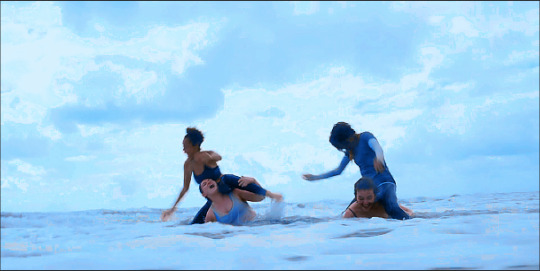
I have this lingering and probably irrational concern that the entire water play scene is choreographed and that it’s chock-full of foreshadowing. Like I know to some extent they likely were just like “yeah guys go goof off in the water,” but like...the wave pulling Rachel and Nora apart here...I mean.... (Rachel is probably gonna get more blood on Dot in the near future, too. ) That aside, their horseplay gets interrupted when Leah notices some blood on Dot, which Rachel realizes is her own period blood.
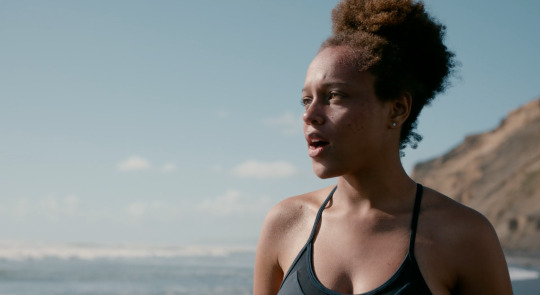
Fatin then chimes in with her ever-gleeful foreshadowing: “Shark week for Rachel.” So while this whole encounter with the water actually seems mostly good for a change, it’s colored by the tie-in to what we know is coming.
In ep nine, reality has set in that rescue isn’t imminent. Everyone’s starving, Leah has started to spiral, and Rachel’s unusually skittish. By the tide’s edge, Nora asks for her help fishing, but Rachel refuses, saying that she’s weak. Nora flicks water at her, and Rachel flinches, clearly scared.
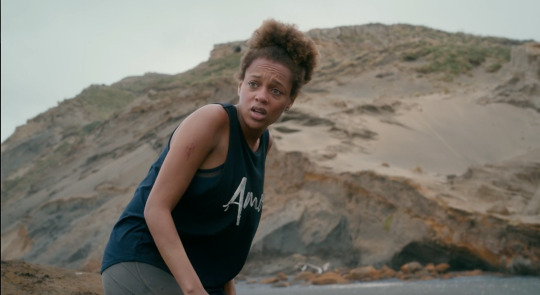
Starvation seems to have triggered Rachel’s trauma around the water leftover from her diving accident. In response, Nora reaches out a hand and says, “Let’s go for a walk.”
Meanwhile, Leah’s spiral has reached critical. She starts ranting about the ocean and the water and pushes past Dot, sprinting into the waves:
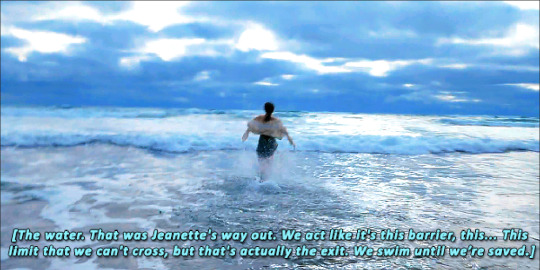
And so she’s taken to heart the way they think Jeannette’s body “escaped” the island—the tide—and it’s been spun like cotton candy in her head. She’s right, technically—Jeanette/Linh’s body was moved off the island by boat, and there’s definitely an argument that if they really did all swim out Gretchen’s team would save them, or at least try to. This is also a very real suicide attempt. So it’s kind of a culmination of the threats of death and mental health issues that’ve been wrapped up in the ocean since the start.
On Rachel’s end, Nora has taken her up to a cliff. Rachel calls the whole thing “borderline insane,” walking up when they’re so low on energy, but Nora tells her she needs to make a truce between herself and the water.
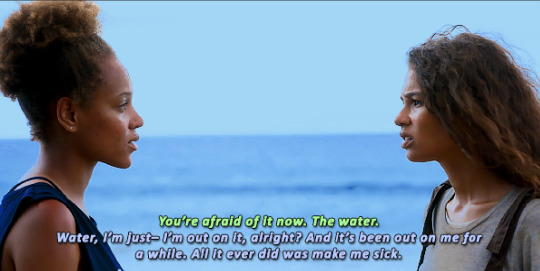
“You’re afraid of it now,” she says, and Rachel replies that, “All it ever did was make me sick.” Nora immediately surges forward to say “That’s not true!” Rachel, incredulous, says, “Isn't this what you want? For me to hang it up? For me to forget the whole fucking diving game?” Nora says, “No. I don't know. I don't want you to forget you.” She then tells Rachel she should dive off the end of the cliff, that she marked it to make sure it’s safe. Rachel says she can’t.
There’s a lot here. First, there’s the first time we’ve seen of Rachel explicitly call herself sick. In episode two, even in a treatment center, she still denies it, says she’s just an athlete who knows what it takes. But now she’s reached a place where she acknowledges her eating disorder—and also probably her recent illness with the mussels—and ties it directly to the water. It’s the reason she’s sick.
Nora’s fear that Rachel will forget herself also just hammers home how central the water has always been to Rachel’s identity. Cutting herself off from the water would be cutting off a core part of herself. (...whoops) And we’ve seen that it does bring her actual joy, when she’s allowed to relax with it, but she’s had such traumatic associations rolled up into it now. Nora doesn’t want Rachel to do diving as a sport anymore, because of how badly it’s hurt her, but she does want Rachel to keep diving and swimming as like, a form of unevaluated personal expression.
At the moment that Rachel’s refusing to jump, she and Nora hear shouts from the mainland. They see Fatin and Dot screaming after Leah. Confused, Nora asks, “Where is she going?” but Rachel understands immediately, with absolute certainty, without needing to be told—“To fucking drown to death.” Seven episodes after Leah called heading into the water a death wish, she’s finally proving it true. Rachel squares her shoulders, takes a few deep breaths, and sprints into a dive.
Unlike all her other dives high altitude dives we’ve seen her do, this dive isn’t qualified based on aesthetics. This dive matters because of what it will do, not on how it looks. And what it does do is bring her into the ocean, where she needs to be for her friend. So with strong strokes, she swims out towards Leah.

When she reaches her, she takes hold of her, pulls her into her chest from behind. She begins to swim with her back to shore. This rescue directly parallels Leah’s rescue of Linh that we talked about above. It also, as the Out in the Wilds podcast insightfully pointed out, really calls Rachel and Leah’s relationship back to the beginning. Whereas Rachel had initially held Leah down in the water, putting her in danger of drowning, Rachel here pulls her out of the water, saving her from drowning. Together, they make it all the way back to the shore.
Finally (and, like, if you’ve made it all the way down here? bless you. thank you), we have episode ten. The ocean doesn’t really figure into episode ten until the very end. Rachel has had a long episode of healing—she’s happy to be full and she’s in a good place with her sister and things seem to be going pretty okay. She decides to heal her relationship with the water, too. She heads out, telling Nora that she’s “Just gonna float, Nor. Just float.”
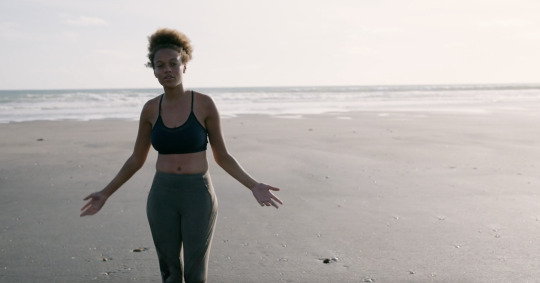
Just floating. After all the times we saw her plunging into the water, purposefully, with frustration, with drive, with so much to prove and with so much sacrifice and self-abuse to prove it with, Rachel finally just wants to float. She wants to let herself relax. She wants to let the water carry her.
Of course, that means there has to be, like, a massive marine carnivore waiting to mistake her for a seal.

Visually, this shot really parallels the opening shot of Leah on the fragment of plane. Instead of being face-down, though, she’s face-up, and she’s conscious, just not of the threat from below.
The shark bites.

In a horrible parallel to Leah’s Virginia Woolf moment and Rachel’s diving accident, we see blood pool in the water. Rachel is pulled under. The girls on the land start screaming and running toward her. We know Rachel doesn’t die, but this is still a near-death experience, one that probably cost her her arm. Leah, covered in dirt and her own blood after crawling out of the pit Nora led her into, can only stand and watch, shocked and horrified.
So that got! Way longer than I meant it to! And honestly most of this was condensed into very concise tags in a post I made a few days ago! But if you made it all the way down here, you’ve now seen everything I wanted to fit into that gifset but couldn’t. Thanks for sticking with me, friend <3
#the wilds#rachel reid#leah rilke#the wilds meta#this got away from me a bit lol#there was absolutely no proofreading on this so if something doesn't make sense...oops#leah x rachel
73 notes
·
View notes